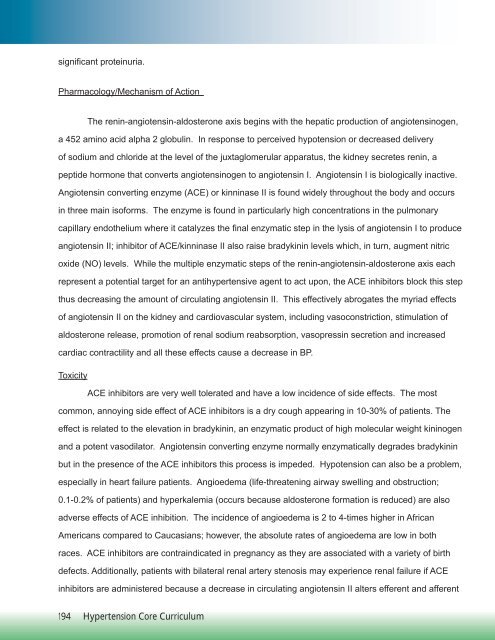michigan hypertension core curriculum - State of Michigan
michigan hypertension core curriculum - State of Michigan
michigan hypertension core curriculum - State of Michigan
You also want an ePaper? Increase the reach of your titles
YUMPU automatically turns print PDFs into web optimized ePapers that Google loves.
significant proteinuria.<br />
Pharmacology/Mechanism <strong>of</strong> Action<br />
The renin-angiotensin-aldosterone axis begins with the hepatic production <strong>of</strong> angiotensinogen,<br />
a 452 amino acid alpha 2 globulin. In response to perceived hypotension or decreased delivery<br />
<strong>of</strong> sodium and chloride at the level <strong>of</strong> the juxtaglomerular apparatus, the kidney secretes renin, a<br />
peptide hormone that converts angiotensinogen to angiotensin I. Angiotensin I is biologically inactive.<br />
Angiotensin converting enzyme (ACE) or kinninase II is found widely throughout the body and occurs<br />
in three main is<strong>of</strong>orms. The enzyme is found in particularly high concentrations in the pulmonary<br />
capillary endothelium where it catalyzes the final enzymatic step in the lysis <strong>of</strong> angiotensin I to produce<br />
angiotensin II; inhibitor <strong>of</strong> ACE/kinninase II also raise bradykinin levels which, in turn, augment nitric<br />
oxide (NO) levels. While the multiple enzymatic steps <strong>of</strong> the renin-angiotensin-aldosterone axis each<br />
represent a potential target for an antihypertensive agent to act upon, the ACE inhibitors block this step<br />
thus decreasing the amount <strong>of</strong> circulating angiotensin II. This effectively abrogates the myriad effects<br />
<strong>of</strong> angiotensin II on the kidney and cardiovascular system, including vasoconstriction, stimulation <strong>of</strong><br />
aldosterone release, promotion <strong>of</strong> renal sodium reabsorption, vasopressin secretion and increased<br />
cardiac contractility and all these effects cause a decrease in BP.<br />
Toxicity<br />
ACE inhibitors are very well tolerated and have a low incidence <strong>of</strong> side effects. The most<br />
common, annoying side effect <strong>of</strong> ACE inhibitors is a dry cough appearing in 10-30% <strong>of</strong> patients. The<br />
effect is related to the elevation in bradykinin, an enzymatic product <strong>of</strong> high molecular weight kininogen<br />
and a potent vasodilator. Angiotensin converting enzyme normally enzymatically degrades bradykinin<br />
but in the presence <strong>of</strong> the ACE inhibitors this process is impeded. Hypotension can also be a problem,<br />
especially in heart failure patients. Angioedema (life-threatening airway swelling and obstruction;<br />
0.1-0.2% <strong>of</strong> patients) and hyperkalemia (occurs because aldosterone formation is reduced) are also<br />
adverse effects <strong>of</strong> ACE inhibition. The incidence <strong>of</strong> angioedema is 2 to 4-times higher in African<br />
Americans compared to Caucasians; however, the absolute rates <strong>of</strong> angioedema are low in both<br />
races. ACE inhibitors are contraindicated in pregnancy as they are associated with a variety <strong>of</strong> birth<br />
defects. Additionally, patients with bilateral renal artery stenosis may experience renal failure if ACE<br />
inhibitors are administered because a decrease in circulating angiotensin II alters efferent and afferent<br />
194 Hypertension Core Curriculum

















